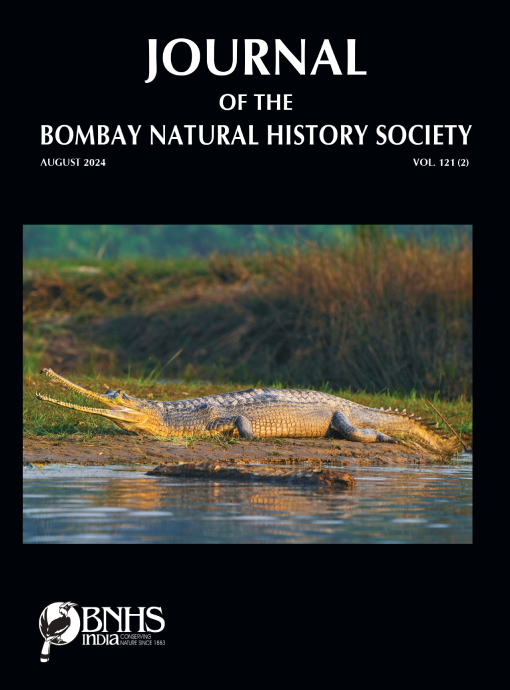Abstract
The habitat utilization and preferences of both Black-headed Ibis and Red-naped Ibis were studied at the Important Bird and Biodiversity Area (IBBA) site in Dighal, Haryana, India, from December 2020 to November 2022. Among various habitats, the Black-headed Ibis was observed most frequently in wetlands, followed by agricultural and barren lands. In contrast, the Red-naped Ibis was primarily observed in agricultural land, followed by barren land and wetlands. Ivlev’s electivity index was used to analyze habitat preferences, revealing that the Black-headed Ibis strongly prefers wetlands (s = +0.88, indicating positive selection), while the Red-naped Ibis favours agricultural land (s = +0.18, indicating positive selection). A significant difference was observed in the selection of wetland and agricultural land habitats by Black-headed Ibis and Red-naped Ibis, respectively, across different seasons. Both species face several threats, including predation, pesticide use, and habitat destruction. This study provides a scientific baseline for future research to better understand the ecology of these ibis species and guide their conservation. The IBBA site provides suitable habitats for the ibises and other flora and fauna, but it is still vulnerable to natural and anthropogenic threats. Protecting such habitats is essential to maintaining a healthy ecosystem for the Black-headed and Red-naped Ibis.References
Anjali & S. Rana (2021): Habitat selection by Black-headed Ibis (Threskiornis melanocephalus) and Red-naped Ibis (Pseudibis papillosa) in the rural areas of district Jhajjar, Haryana, India. International Journal of BioSciences & Technology 14(2): 18–27. http://doi.org/10.5281/zenodo.5596613
Anjali & S. Rana (2022): Population abundance and threats to Blackheaded Ibis Threskiornis melanocephalus and Red-naped Ibis Pseudibis papillosa at study sites in Jhajjar district, Haryana, India. Journal of Threatened Taxa 14(11): 22148–22155. https://doi.org/10.11609/jott.7774.14.11.22148-22155.
Balakrishnan, M. & S.K. Thomas (2004): Conserving the breeding habitat of the Near Threatened Oriental White ibis (Threskiornis melanocephalus). Current Science 87(9): 1190 –1192. https://www.researchgate.net/publication/255493163_ Breeding_of_the_Oriental_White_Ibis_Threskiornis_ melanocephalus_at_Kumarakom_heronry_Kerala_India/ link/55a937f608ae815a042541e0/download
Barik, S., G.K. Saha & S. Mazumdar (2021): How the Habitat Features Influence Black- Headed Ibis (Threskiornis melanocephalus) in a Suburban Area? A Study from Mid-West Bengal, India. In Proceedings of the Zoological Society 75(1): 39–47. https://doi.org/10.1007/s12595-021-00385-3
Bote, M.A., V.R. Naik & K.B. Jagadeesh Gouda (2020): Review on water hyacinth weed as a potential bio fuel crop to meet collective energy needs. Materials Science for Energy Technologies 3: 397–406. https://www.sciencedirect.com/science/article/pii/S2589299120300082
Choudhury, A. (2012): Status of Oriental White Ibis (Threskiornis melanocephalus) in Assam with notable recent records. Indian BIRDS 7(6): 163. http://indianbirds.in/pdfs/IB7.6_Choudhury_ OrientalWhiteIbis.pdf
Choudhury, S. (2018): Study on the distribution, ecology and ethology of Black-headed Ibis (Threskiornis melanocephalus) in southern Rajasthan. Mohanlal Sukhadia University, Udaipur, Rajasthan, India.
Choudhury, S. & V.K. Koli (2018): Population status, habitat preference, and nesting characteristics of Black-headed Ibis (Threskiornis melanocephalus) (Latham, 1790) in southern Rajasthan, India. Journal of Asia-Pacific Biodiversity 11(2): 223–228. https://doi.org/10.1016/j.japb.2018.01.013
Dwevedi, R., V. Krishna, S.K. Singh & A. Kumar (2018): A village heronry of Black-headed Ibis (Threskiornis melanocephalus) in Haryana: Threats and conservation needs. Advances in Bioresearch 9(2). https://doi.org/10.15515/abr.0976-4585.9.2.223226
Godefriod, S. (2001): Temporal analysis of Brussel flora as indicator for changing environmental quality. Landscape and urban planning 52: 883–890. https://www.academia.edu/49728807/ Temporal_analysis_of_the_Brussels_flora_as_indicator_for_ changing_environmental_quality
Gulati, H. & S. Rana (2022): Habitat preference and current threats to the Sarus Cranes Grus antigone (Aves: Gruiformes: Gruidae) in Important Bird Areas of Haryana, India: Implications for determining effective conservation actions. Journal of Advanced Zoology 43(1): 07–16. http://jazindia.com/index.php/jaz/article/ view/110
Hancock, J.A., J.A. Kushlan & M.P. Kahl (2001): Storks, Ibises and Spoonbills of the world. Academic Press, London.
Harris, J. & C. Mirande (2013): A global overview of cranes: status, threats and conservation priorities. Chinese Birds 4(3): 189–209. https://doi.org/10.5122/cbirds.2013.0025 IUCN (2023): The IUCN Red List of Threatened Species. www.iucnredlist.org
Ivlev, V.S. (1961): Experimental Ecology of the Feeding of Fishes. New York, USA: Yale University Press. 302. https://www.scirp.org/(S(i43dyn45teexjx455qlt3d2q))/reference/ReferencesPapers.aspx?ReferenceID=1538235
Jacobs, J. (1974): Quantitative measurements of food selection. A modification of the forage ratio and Ivlev’s electivity index. Oecologia 14(4): 413–417. https://doi.org/10.1007/BF00384581
Kong, D.J., X.J. Yang, Q. Liu, X.Y. Zhong & J.X. Yang (2011): Winter habitat selection by the vulnerable black-necked crane Grus nigricollis in Yunnan, China: implications for determining effective conservation actions. Oryx 45(2): 258–264. https://doi.org/10.1017/S0030605310000888
Krausman, P.R. (1999): Some basic principles of habitat use. Grazing behavior of livestock and wildlife 70: 85–90. https://scholar.google.com/scholar?hl=en&as_sdt=0%2C5&q=Krausman%2C+P.+R.+1 999.+Some+basic+principles+of+habitat+use.+Grazing+behavio r+of+livestock+and+wildlife+70%3A+85-90.&btnG
Kumar, A. & S. Rana (2021): Population and conservation threats to the Greater Flamingos Phoenicopterus roseus (Aves: Phoenicopteriformes: Phoenicopteridae) at Basai Wetland and Najafgarh Jheel Bird Sanctuary, Haryana, India. Journal of Threatened Taxa 13(7): 18894–18898. https://doi.org/10.11609/ jott.6258.13.7.18894-18898
Luo, K., Z. Wu, H. Bai & Z. Wang (2019): Bird diversity and waterbird habitat preferences in relation to wetland restoration at Dianchi Lake, south-west China. Avian Research 10(1): 1–12. https://avianres.biomedcentral.com/articles/10.1186/s40657019-0162-9
Paliwal, G.T. & S.V. Bhandarkar (2017): Ecology and Conservation of Threatened Birds in and around Navegaon National Park, Maharashtra. Essence - International Journal for Environmental Rehabilitation and Conservation 1: 120–135.
Rahmani, A.R., M.Z. Islam & R.M. Kasambe (2016): Important Birds and Biodiversity Areas in India: Priority Sites for Conservation. 2nd Edn. Bombay Natural History Society, Mumbai.
Rajesh & M. Kumar (2017): Abundance and feeding ecology of Black Ibis (Pseudibis papillosa) in agricultural fields of Punjab, India. Journal of Entomology and Zoology Studies 54: 992–995. https://www.cabdirect.org/cabdirect/abstract/20193431439
Rasmussen, P.C. (2004): Threatened Birds of Asia: The BirdLife International Red Data Book. The Auk 121(2): 619–622. https://doi.org/10.1093/auk/121.2.619
Thapa, J.B. & T.B. Saund (2012): Water quality parameters and bird diversity in Jagdishpur Reservoir, Nepal. Nepal Journal of Science and Technology 13(1): 143–155. https://doi.org/10.3126/njst.v13i1.7453
Wood, K.A. & R.A. Stillman (2014): Do birds of a feather flock together? Comparing habitat preferences of piscivorous waterbirds in a lowland river catchment. Hydrobiologia 738(1): 87–95. https://link.springer.com/article/10.1007/s10750-014-1921-6

